On this day on 10th August
On this day in 1913 Catherine Marshall explains to John Simon why she was leaving the Liberal Party. over the government's failure to give women the vote.
"I left school I started working for the Liberal Party almost as hard as I am working for women's suffrage now. It has been the greatest disillusionment of my life to find how little these principles really count with the majority of Liberal men. They seem to regard them as catchwords to pad a leaflet or adorn a peroration, not as vital principles to be applied in their dealings with other human beings... So long as you feel that the Prime Minister's attitude makes it impossible for you to bring any pressure to bear on your party from within... a great deal of our work fails to bear all the fruit it might, so far as the Liberal party is concerned."
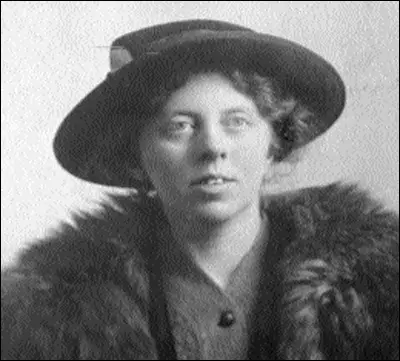
On this day in 1914 the government release all Women Social & Political Union (WSPU) prisoners. The WSPU carried out secret negotiations with the government and on the 10th August the government announced it was releasing all suffragettes from prison. In return, the WSPU agreed to end their militant activities and help the war effort. Christabel Pankhurst, arrived back in England after living in exile in Paris. She told the press: "I feel that my duty lies in England now, and I have come back. The British citizenship for which we suffragettes have been fighting is now in jeopardy."
After receiving a £2,000 grant from the government, the WSPU organised a demonstration in London. Members carried banners with slogans such as "We Demand the Right to Serve", "For Men Must Fight and Women Must Work" and "Let None Be Kaiser's Cat's Paws". At the meeting, attended by 30,000 people, Emmeline Pankhurst called on trade unions to let women work in those industries traditionally dominated by men. She told the audience: "What would be the good of a vote without a country to vote in!".
In October 1915, The WSPU changed its newspaper's name from The Suffragette to Britannia. Emmeline's patriotic view of the war was reflected in the paper's new slogan: "For King, For Country, for Freedom'. The newspaper attacked politicians and military leaders for not doing enough to win the war. In one article, Christabel Pankhurst accused Sir William Robertson, Chief of Imperial General Staff, of being "the tool and accomplice of the traitors, Grey, Asquith and Cecil". Christabel demanded the "internment of all people of enemy race, men and women, young and old, found on these shores, and for a more complete and ruthless enforcement of the blockade of enemy and neutral."
Anti-war activists such as Ramsay MacDonald were attacked as being "more German than the Germans". Another article on the Union of Democratic Control carried the headline: "Norman Angell: Is He Working for Germany?" Mary Macarthur and Margaret Bondfield were described as "Bolshevik women trade union leaders" and Arthur Henderson, who was in favour of a negotiated peace with Germany, was accused of being in the pay of the Central Powers. Her daughter, Sylvia Pankhurst, who was now a member of the Labour Party, accused her mother of abandoning the pacifist views of Richard Pankhurst.
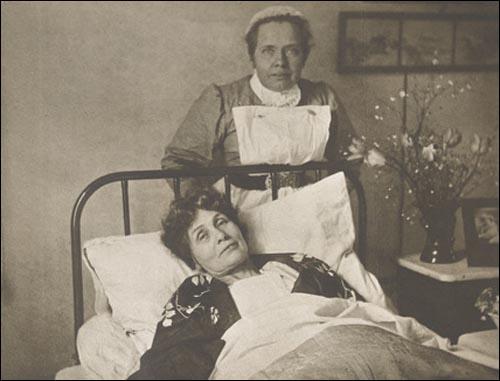
On this day in 1917 Arthur Henderson, leader of the Labour Party, calls for peace talks with Germany. At a conference of the Labour Party held in London on 10th August, 1917, Henderson made a statement recommending that the Russian invitation to the Stockholm Conference should be accepted. Delegates voted 1,846,000 to 550,000 in favour of the proposal and it was decided to send Henderson and Ramsay MacDonald to the peace conference. However, under pressure from President Woodrow Wilson, the British government had changed his mind about the wisdom of the conference and refused to allow delegates to travel to Stockholm. As a result of this decision, Henderson resigned from the government.
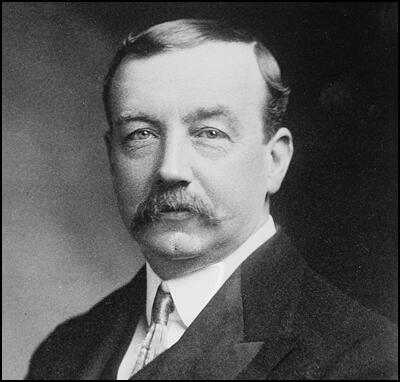
On this day in 1929 Dutch feminist Aletta Jacobs died.
Aletta Jacobs, the eighth of twelve children, was born in the Netherlands on 9th February, 1854. Her father was a doctor and she decided at an early age she wanted to be a member of the same profession. At this time boys and girls received different forms of secondary education. Whereas girls studied languages, art, music and handicrafts to prepare them for life as a wife and mother, a boy's education included mathematics, history, Greek, and Latin. Aletta's father managed to persuade the local boys' high school to allow his daughter to attend these classes.
After leaving high school, Jacobs went to live with one of her brothers who worked as a pharmacist. He taught her the trade and she eventually passed the relevant pharmacist exam. In 1872 she received special permission from the government to enter the University of Gröningen.
Jacobs passed her university exams in Mathematics and Physics and in 1876 entered the medical school in Amsterdam. Jacobs later wrote that during her studies she "encountered professors who openly opposed the idea of women doctors". However, she also received the strong support from other teachers and she successfully obtained her medical degree on April 2, 1878.
During the summer of 1878 Jacobs visited London where she met other feminists. This included Elizabeth Garrett Anderson who had qualified as a doctor in 1865. On her return to the Netherlands she became involved in several campaigns to improve the conditions of working class women.
Jacobs also became involved in providing women with birth-control. In her autobiography Jacobs wrote: "For social, moral, and medical reasons, women from different social classes had often asked me for some form of contraception. I had always had to fend off these requests without providing adequate explanation or advice. Eventually I sent letters to a number of women whose need was greatest. I told them that I believed I had found a means to help them, but before I could fully recommend it, they would have to agree to regular examinations during the first months of its use. Some of these women eventually agreed to the experiment, and the results were such that, some months later, I was able to announce that I could provide a safe and effective contraceptive."
Despite opposition from religious and political leaders, Jacobs started a national campaign to make contraception widely available in the Netherlands. Her birth-control clinic in Amsterdam open over 30 years before those in the United States and Britain. Her success inspired the activities of other birth-control advocates and Margaret Sanger and Marie Stopes both traveled to the Netherlands to find out more about the work of Jacobs.
Jacobs was also inspired by the work of feminists in other countries. For example, she took a keen interest in the activities of Josephine Butler who had campaigned against the Contagious Diseases Act in Britain. These acts had been introduced in the 1860s in an attempt to reduce venereal disease in the armed forces. Butler objected in principal to laws that only applied to women. Under the terms of these acts, the police could arrest women they believed were prostitutes and could then insist that they had a medical examination. Butler had considerable sympathy for the plight of prostitutes who she believed had been forced into this work by low earnings and unemployment. Jacobs shared Butler's concerned and campaigned against organized prostitution (white slave traffic).
In 1883 Jacobs attempted unsuccessfully to register to vote. This was the beginning of her campaign for universal suffrage. This generated a great deal of support after the Dutch Parliament, added the word "male" to the list of voting qualifications in 1887.
In 1893 Jacobs helped establish the Vereeniging voor Vrouwenkiesrecht (Woman Suffrage Alliance). Jacobs became head of the Amsterdam section and in 1903 she was elected president of the organization. Jacobs worked closely with other organizations such as the National Woman Suffrage Association and the National Union of Suffrage Societies and in 1904 was a founder member of the International Woman Suffrage Alliance (IWSA). This included feminists from the United States, Britain, Norway, Sweden, Denmark, Australia, and Germany.
Aletta Jacobs became one of the most important international figures in the fight for universal suffrage. In 1911 she joined Carrie Chapman Catt in a world fact-finding tour. This included visits to South Africa, Syria, Egypt, Ceylon (Sri Lanka), India, Burma, Singapore, the Dutch East Indies, the Philippines, China, and Japan.
On the outbreak of the First World War a group of women pacifists in the United States began talking about the need to form an organization to help bring it to an end. On the 10th January, 1915, over 3,000 women attended a meeting in the ballroom of the New Willard Hotel in Washington and formed the Woman's Peace Party. Jane Addams was elected president and other women involved in the organization included Mary McDowell, Florence Kelley, Alice Hamilton, Anna Howard Shaw, Belle La Follette, Fanny Garrison Villard, Mary Heaton Vorse, Emily Balch, Jeanette Rankin, Lillian Wald, Edith Abbott, Grace Abbott, Crystal Eastman, Carrie Chapman Catt and Sophonisba Breckinridge.
In April 1915, Jacobs invited members of the Woman's Peace Party to an International Congress of Women in the Hague. Jane Addams was asked to chair the meeting and Mary Heaton Vorse, Alice Hamilton, Grace Abbott, Julia Lathrop, Leonora O'Reilly, Sophonisba Breckinridge and Emily Bach went as delegates from the United States. Others who went to the Hague included Emmeline Pethick-Lawrence, Emily Hobhouse, (England); Chrystal Macmillan (Scotland) and Rosika Schwimmer (Hungary). Afterwards, Jacobs, Addams, Macmillan, Schwimmer and Balch went to London, Berlin, Vienna, Budapest, Rome, Berne and Paris to speak with members of the various governments in Europe.
Throughout this period Jacobs continued to campaign for universal suffrage. The vote was granted to women in Finland (1906), Norway (1907), Denmark (1915), Russia (1917), Germany (1918), Britain (1918), Poland (1918), Austria (1918), Czechoslovakia (1918) and Hungary (1918). Like the women of Luxemburg, Belgium and Sweden, the Netherlands had to wait until 1919 before obtaining the vote.
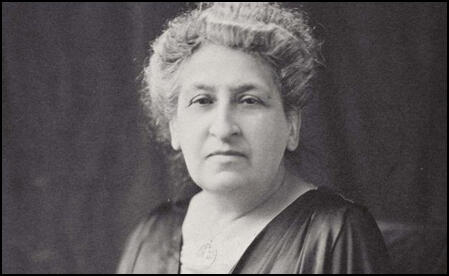
On this day in 1936 Winston Churchill writes article praising General Francisco Franco and his Fascist forces during the Spanish Civil War. He described the democratically elected Republican government as "a poverty stricken and backward proletariat demanding the overthrow of Church, State and property and the inauguration of a Communist regime." Against them stood the "patriotic, religious and bourgeois forces, under the leadership of the army, and sustained by the countryside in many provinces... marching to re-establish order by setting up a military dictatorship."
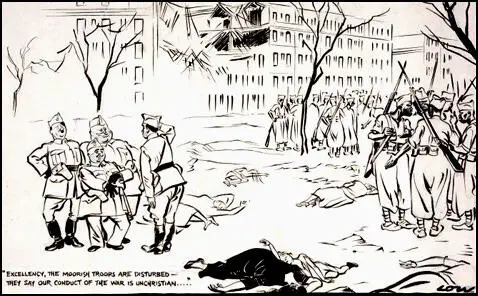
On this day in 1936 the poet John Cornford wrote a letter to Margot Heinemann about fighting in Spanish Civil War.
Last night we began to make ourselves more comfortable-dug little trenches to sleep in and filled them with straw. So long as I am doing anything, however purposeless, I feel fine. It's inactivity that just cats at my nerves. But the night before last I had a dream. One of the toughest people when I was small at school was the captain of rugger, an oaf called D. I was in the same dormitory and terrified of him. I hadn't thought of him for years, but last night I dreamt extremely vividly about having a fight with him and holding my own, and I think that's a good omen. I don't know how long we stay on this hill, but I am beginning to settle down to it. ...
Now a bit about the political situation. That isn't easy to get straight, particularly as I haven't yet heard anyone explain the position of the Party (and the militia here I am with are P.O.U.M. - left sectarian semi-Trotskyists). But roughly this. The popular front tactics were worked magnificently to begin with. They won the elections. And under the slogan of defence of the Republic, they enabled us to arm the workers when the Fascist revolt started. Up till then the position is quite clear. But now in Catalonia things are like this. There is a left Republican Government. But, in fact, the real power is with the workers...
In Barcelona one can understand physically what the dictatorship of the proletariat means. All the Fascist press has been taken over. The real rule is in the hands of the militia committees. There is a real terror against the Fascists. But that doesn't alter the fact that the place is free-and conscious all the time of its freedom. Everywhere in the streets are armed workers and militiamen, and sitting in the cafes which used to belong to the bourgeoisie. The huge Hotel Colon overlooking the main square is occupied by the United Socialist Party of Catalonia. Further down, in a huge block opposite the Bank of Spain, is the Anarchist headquarters. The palace of a marquis in the Rambla is a C.P. Headquarters. But one does not feel the tension. The mass of the people ... simply are enjoying their freedom. The streets are crowded all day, and there are big crowds round the radio palaces. But there is nothing at all like tension or hysteria. It's as if in London the armed workers were dominating the streets - it's obvious that they wouldn't tolerate Mosley or people selling Action in the streets. And that wouldn't mean that the town wasn't free in the real sense. It is genuinely a dictatorship of the majority, supported by the over-whelming majority.
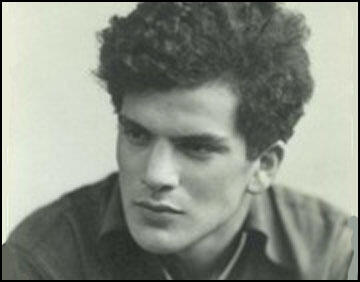
On this day in 1942 Rex Stout explains the need to destroy fascism. "The American people must be taught the nature of our enemy in order to eliminate the possibility of a premature peace.... The chief difficulty to any peace in this world is not the momentary, spasmodic vices of the Nazis but the inherent anti-democratic traits in the German character. We must understand them in order to convince them that the only way to get along in this world is to cooperate with democracy. If we could convince them by giving each of them a copy of the Declaration of Independence, that would be fine. If we can only convince them by killing twenty million of them, we must do that."
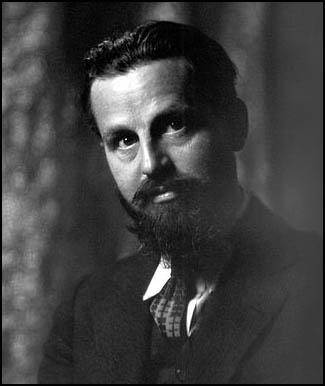
On this day in 1961 the U.S. Army begins Operation Ranch Hand during the Vietnam War. As the United States is the most advanced industrial nation in world it was able to make full use of the latest developments in technology in its war against North Vietnam. B-52 bombers, that could fly at heights that prevented them being seen or heard, dropped 8 million tons of bombs on Vietnam between 1965 and 1973. This was over three times the amount of bombs dropped throughout the whole of the Second World War and worked out at approximately 300 tons for every man, woman and child living in Vietnam.
As well as explosive bombs the United States Air Force dropped a considerable number of incendiary devices. The most infamous of these was napalm, a mixture of petrol and a chemical thickner which produces a tough sticky gel that attaches itself to the skin. The igniting agent, white phosphorus, continues burning for a considerable amount of time. A reported three quarters of all napalm victims in Vietnam were burned through to the muscle and bone (fifth degree burns). The pain caused by the burning is so traumatic that it often causes death.
The US also made considerable use of anti-personnel bombs. The pineapple bomb was made up of 250 metal pellets inside a small canister. Gloria Emerson, a reporter in Vietnam, witnessed their use: "An American plane could drop a thousand pineapples over an area the size of four football fields. In a single air strike two hundred and fifty thousand pellets were spewed in a horizontal pattern over the land below, hitting everything on the ground."
The United States also experimented with the use of plastic rather than metal needles and pellets in their antipersonnel bombs. The advantage of plastic was they could not be identified by X-Ray machines. Dropped on highly populated areas, antipersonnel bombs could severely disrupt the functioning of North Vietnam. It has been claimed that the major objective of the US bombing raids on North Vietnam was not to kill its 17 million population but to maim them. As was pointed out at the time, serious injury is more disruptive than death as people have to be employed to look after the injured where they only have to bury the dead.
One of the major problems of the US forces was the detection of the National Liberation Front hiding in the forests of Vietnam. In 1962, President John F. Kennedy approved Operation Ranch Hand. This involved the spraying of chemicals from the air in an attempt to destroy the National Liberation Front hiding places. In 1969 alone, Operation Ranch Hand destroyed 1,034,300 hectares of forest. Agent Orange, the chemical used in this defoliation programme not only destroyed trees but caused chromosomal damage in people.
Chemicals were also sprayed on crops. Between 1962 and 1969, 688,000 agricultural acres were sprayed with a chemical called Agent Blue. The aim of this exercise was to deny food to the NLF. However, research suggests that it was the civilian population who suffered most from the poor rice harvests that followed the spraying.
When a report appeared in the St. Louis Dispatch about the dropping of "poison" on North Vietnam the United States denied the herbicide they were using was a chemical weapon. It was claimed that Agent Orange and Agent Blue were harmless to humans and only had a short-lived impact on the environment.
This was disputed by international experts and 5,000 American scientists, including 17 Nobel prize winners and 129 members of the Academy of Sciences, signed a petition against chemical and biological weapons being used in Vietnam. However, it was not until 1974 that the United States government stopped using Agent Orange and Agent Blue.
During the war about 10% of Vietnam was intensively sprayed with 72 million litres of chemicals, of which 66% was Agent Orange. Some of this landed on their own troops and soon after the war ended veterans began complaining about serious health problems. There was also a high incidence of their children being born limbless or with Down's syndrome and spina bifida. The veterans sued the defoliant manufacturers and this was settled out of court in 1984 by the payment of $180 million.
The TCCD dioxin used in Agent Orange seeped into the soil and water supply, and therefore into the food chain. In this way it passed from mother to foetus in the womb. In Vietnam the dioxide remains in the soil and is now damaging the health of the grandchildren of the war's victims.
A report published in 2003 claimed that 650,000 people in Vietnam were still suffering from chronic conditions as a result of the chemicals dropped on the country during the war. Since the war the Vietnamese Red Cross has registered an estimated one million people disabled by Agent Orange. It is estimated that 500,000 people in Vietnam have died from the numerous health problems created by these chemical weapons.
Agent Orange being dropped on Vietnam 30 years ago.

